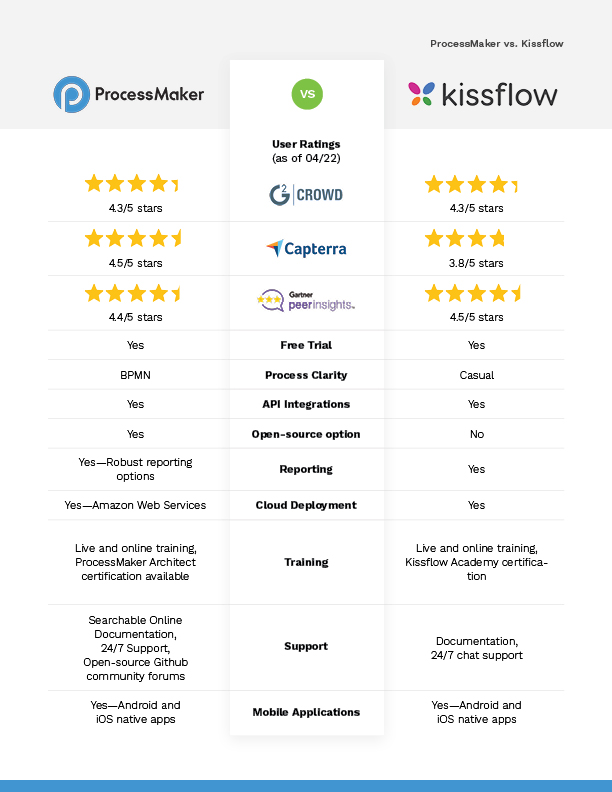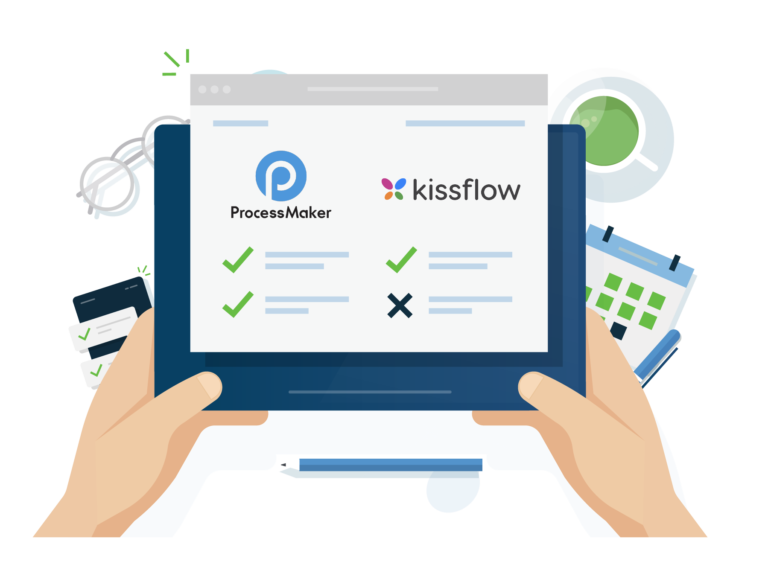So your team is ready to digitize your outdated paper-based processes. Or maybe you’re ready to upgrade from a basic flowchart tool to a fully automated BPM platform. Whatever position you are in, there are dozens of options chasing your attention, and you’re likely having trouble sorting out the differences. Let us help you weigh the pros and cons of two popular workflow platforms, ProcessMaker and Kissflow, so that you can make the right decision for your team.
Getting started
One of the main things you’ll want to prioritize when selecting a BPM is how code-heavy the platform is.
High-code platforms require massive technical wherewithal. If you’re not an expert in Java, C#, or Python, you’re unable to build apps or workflows. ProcessMaker and Kissflow welcome a broader spectrum of users into the development fold by using a technique called low-code.
Low-code platforms unlock the ability to collaborate on development projects by reshaping how we work with computers. Instead of typing out complex syntax, you can drag and drop actions, decision points, and API integrations onto a canvas-like program that feels more like PowerPoint than Eclipse.
Although they’re both low-code, the features and functions of these two platforms start to diverge as process sophistication increases. Maybe that’s why ProcessMaker is an excellent choice for many Fortune 100 companies, or why G2 Crowd named ProcessMaker the “Easiest to Use” for enterprise clients. Let’s dive into the reasons why ProcessMaker tops the charts.
ProcessMaker vs. Kissflow at a glance

Why ProcessMaker?
Kissflow is a great choice for designing standalone or straightforward processes. But organizations need access to more sophisticated workflow tools as they grow and scale. ProcessMaker focuses on linking the needs of business analysts and citizen developers with IT teams that need to manage the holistic system.
Meeting the demands of the most complex business workflows
Each platform has its own pros and cons, depending on the types of workflows you’re hoping to execute. Kissflow is a great starting block for working with more basic and straightforward processes. But as your organization scales, you need access to more sophisticated process tools. That’s why complex industries like banking and higher education enjoy ProcessMaker’s ability to handle more layered automated workflows like commercial bank account opening and college application processing.
Boosting collaboration through BPMN
ProcessMaker is powered by Business Process Management Notation (BPMN). When teams don’t use a common language like BPMN in their process design, they’re prone to developing their own dictionary of “inside baseball” terms. If you’re using lingo that only a handful of people understand, it is far more challenging to concisely illustrate your processes to a broader set of stakeholders.
Using BPMN, ProcessMaker solves this common problem by introducing a standard set of terms, shapes, and symbols that explain how a process flows. When you’re working with global teams that speak multiple languages, or just collaborating with remote workers across town, you can’t risk ambiguity. With BPMN, everyone from outside contractors to clients and freelancers on the other side of the world can understand—and properly implement—the workflow.
Robust reporting functions
When you’re interested in fine-tuning the efficiency of your processes, few things matter more than your reporting features. After all, the power to act on your data instead of just storing it lies in the reporting capabilities of your BPM. ProcessMaker offers a robust library of reports, charts, and dashboard analytics. Can’t find what you’re looking for? Easily create specialized reports that suit the needs of your management team.
All trademarks, service marks, and company names are the property of their respective owners.


